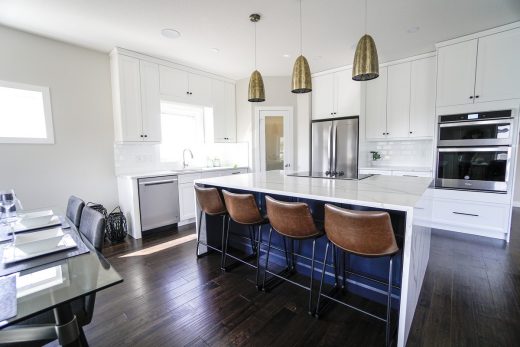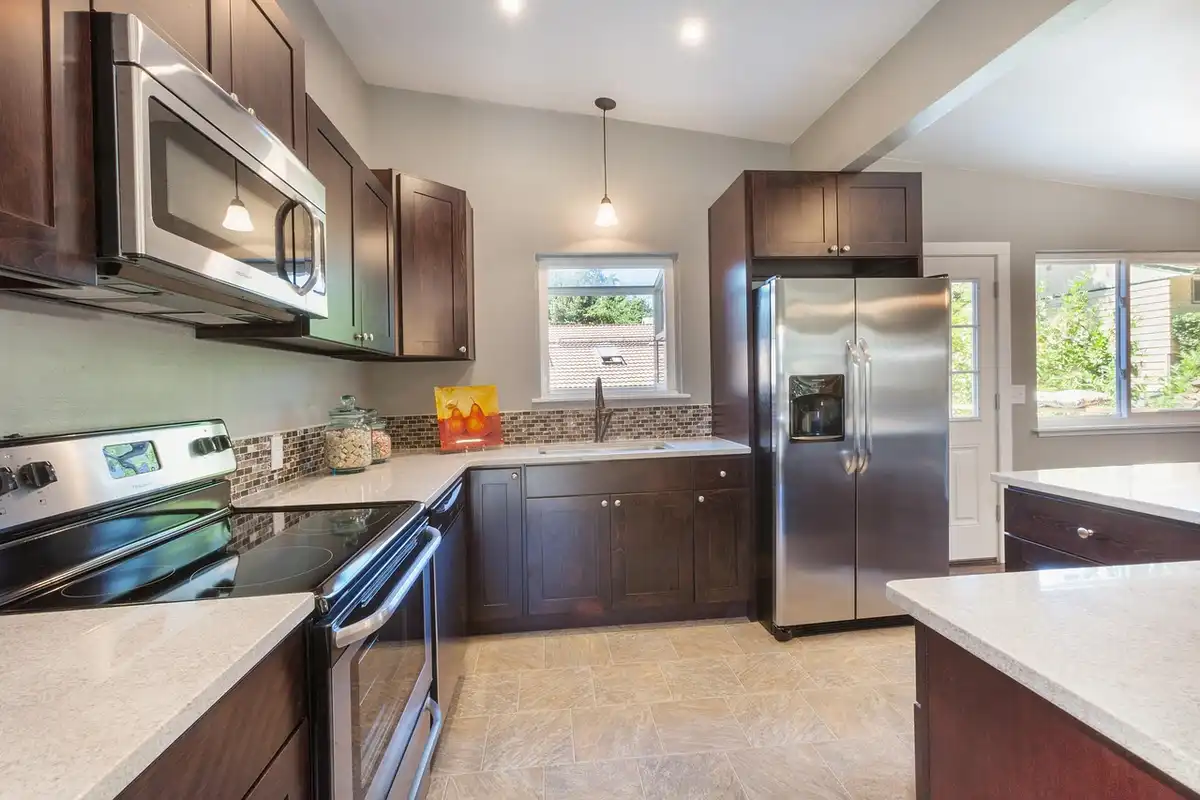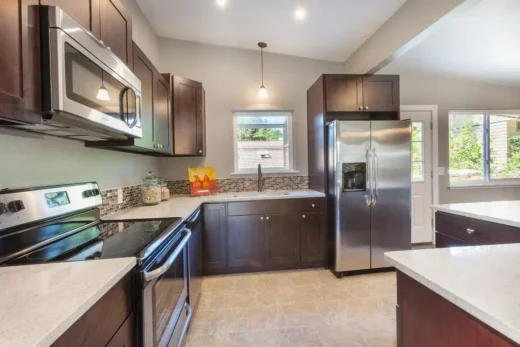Why quartz remains the reliable choice for modern kitchen countertops, Kitchen counter design, Property interior style
Why Quartz Remains the Reliable Choice For Modern Kitchen Countertops
11 May 2025
Quartz has long been valued for its strength and resilience. Long before it became a go-to material for kitchen design countertops, quartz played a quiet but vital role in shaping early human survival and modern science. From ancient fire-making tools to timekeeping innovations, the mineral has maintained its utility across centuries.
Now, it brings that same reliability into kitchens, not just as a surface, but as a functional design element.
What Makes Quartz Worktops So Resilient?
Quartz is composed primarily of silicon dioxide (SiO₂), a compound formed from two of the most abundant elements in Earth’s crust. This natural mineral appears in many types of rock and sediment and is known for its remarkable hardness and chemical stability. That durability isn’t just a geological fact – it’s one of the key reasons why quartz has become a popular surface material for kitchens.
In engineered quartz, crushed quartz crystals are combined with resin binders and pigments, resulting in a dense, non-porous slab. Unlike granite or marble, which often vary in tone and veining, quartz worktops offer a controlled, uniform finish. This consistency has made it easier for designers and homeowners to match surfaces with cabinetry, backsplashes and flooring.
It is this internal structure – the way the quartz crystals lock together during processing – that gives the surface its strong resistance to mechanical and thermal stress. This quality makes quartz an ideal work surface for kitchens that see frequent use.
How Is Quartz Manufactured?
The production of engineered quartz involves mixing roughly 90 to 95 percent ground quartz with polymer resins and pigments. The mixture is then pressed into slabs under high pressure and heated to form a solid, compact surface. This process mimics certain geological processes that naturally form quartz over millions of years, but it takes just hours in a factory.
Thanks to advances in industrial technology, modern quartz slabs can resemble natural stones or offer completely original patterns. While natural quartz forms slowly from molten rock or hydrothermal fluids, manufacturers are now able to replicate this crystal formation through synthesis, creating purer, more predictable materials on a commercial scale.
This control over the process allows suppliers to offer surfaces with consistent veining, color tones, and edge details – attributes that are difficult to find in natural stone.
What Kind of Performance Can Homeowners Expect?
Quartz worktops offer an appealing blend of beauty and practicality.
The surface is non-porous, meaning it resists liquids, oils and bacteria far better than untreated natural stone. Because of this, there is no need for sealants or waxes, and cleaning becomes a simple task of wiping with soap and water.
Engineered quartz also performs well against everyday wear. It stands up to minor impacts, resists scratching from utensils, and avoids the staining that often affects porous materials like marble. It is, however, still advisable to use trivets and heat pads for hot cookware. Although it can withstand moderate heat, direct contact with pots or pans from the stove may discolor the resin content.
| Property | Quartz | Granite | Marble |
| Porosity | Non-porous | Slightly porous | Highly porous |
| Scratch Resistance | High | High | Moderate |
| Stain Resistance | Excellent | Good | Low |
| Heat Resistance | Moderate | High | Low |
| Required Maintenance | Low (no sealing) | Moderate (sealing) | High (frequent care) |
| Pattern Consistency | High | Low | Moderate |
These characteristics make quartz one of the lowest-maintenance options available for busy kitchens without compromising on appearance.
Where Else Does Quartz Show Up in the Kitchen?
Beyond kitchen worktops, this material plays an unexpected but critical role in various kitchen technologies. Due to its piezoelectric properties, this material can generate a steady electrical signal when mechanically stressed. This unique feature has been essential in timekeeping devices, pressure sensors, and even microbalances used in kitchen appliances.
In many modern homes, this material can be found behind the scenes in the timing systems of smart ovens, scales, and other precision devices. Its use in electronics stems from the same mineralogical qualities that make it ideal as a worktop – chemical stability, strength and resistance to wear.
Is Quartz a Sustainable Choice?
Sustainability is a key factor these days. And quartz is a very sustainable choice, as it’s longevity as a kitchen worktop reduces the need for frequent replacement.
In addition, many manufacturers now use recycled quartz particles and are improving factory efficiency to cut down on waste and water usage. While this material is still a mined material, its engineered variants can be sourced and produced with better control over environmental impact than some natural stones.
The production process also offers the advantage of making full use of raw quartz material that might otherwise be discarded due to flaws or irregularities. Through refinement, those off-cuts are transformed into solid, beautiful work surfaces that hold up over time.
| Material | Typical Lifespan | Recyclable Content | Factory Emissions Control |
| Quartz | 20+ years | Yes (partial) | Improved |
| Laminate | 5–10 years | No | Low |
| Wood Butcher Block | 10–15 years | Yes (full) | Moderate |
| Marble | 15–25 years | No | High |
A longer product lifespan means fewer replacements over the years, translating to lower waste and cost over the long term.
How Does Quartz Support Kitchen Design?
One of its strongest visual benefits is its ability to replicate high-end natural stones without the maintenance those materials require. Whether the homeowner prefers the subtle flecks of Carrara marble or the drama of dark veining, quartz slabs can match nearly any design scheme.
Because engineered quartz is non-porous and uniform, the joins between pieces are often less visible than in natural stone installations. This seamless appearance contributes to cleaner lines in both modern and traditional kitchens. The ability to color-match backsplashes, islands, and window sills provides additional design freedom.
Many clients prefer this material for its hygienic properties and visual clarity. A polished surface reflects light well, enhancing the brightness of a kitchen space without sacrificing usability.
| Finish Type | Surface Appearance | Light Reflection | Maintenance Level |
| Polished | Glossy, sleek | High | Low |
| Honed | Matte, soft feel | Moderate | Medium |
| Textured | Tactile, grainy | Low | Medium-High |
The finish affects not just the look but also how the surface behaves under daily use, such as fingerprint visibility and ease of cleaning.
What Should You Know Before Choosing Quartz?
Quartz worktops are suitable for kitchens that handle frequent cooking and entertaining. They perform well under daily use but should be treated with care when dealing with high heat. Using trivets, coasters and cutting boards can help prolong the surface’s appearance and performance.
Cost is typically in the mid to high range compared to other materials, but that price includes reduced maintenance and a long service life. Homeowners who prioritize easy upkeep, consistent quality, and broad design options often find this material to be a worthwhile investment.
Clients should also consider visiting a showroom before making a decision.
At The Beauty of Marble in North Ayrshire, visitors can see full slabs, get hands-on with samples and speak with experienced staff about finishes and fabrication options. Based in Kilwinning, North Ayrshire, their kitchen worktops have been fitted across Scotland and beyond, including custom quartz installations for Six By Nico in London and Dublin. Every piece is handcrafted to meet the highest standards and they offer expert support from the initial consultation to the final polish.
Final Word: A Material with Staying Power
Quartz offers more than just style – it delivers performance rooted in science and built for everyday use. Its structure reflects the geological processes that formed it, while its engineered form meets the demands of the modern kitchen. For homeowners who want reliability, visual consistency and ease of care, quartz worktops represent a sound choice.
Comments on this guide to Why Quartz Remains the Reliable Choice For Modern Kitchen Countertops article are welcome.
Home Kitchen Countertops
Home Kitchen Countertop Design Posts
What are contemporary countertops

Black Granite vs. Black Quartz countertops
5 reasons to pick kitchen natural stone countertops
Install countertops before selling your house
Kitchen Countertops: tiling & backsplash design
Property Articles
Property Articles – Selection
Comments / photos for the Why Quartz Remains the Reliable Choice For Modern Kitchen Countertops page welcome.





